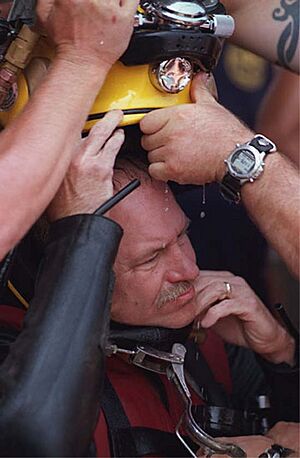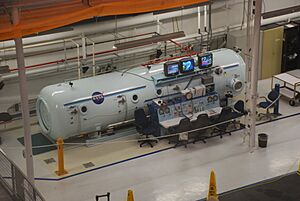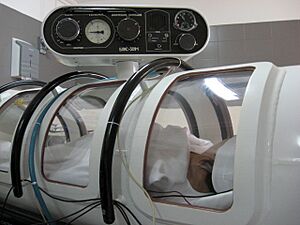Decompression sickness facts for kids
Decompression sickness, also known as the bends, happens when tiny bubbles form inside your body. This usually occurs when the pressure around you changes too quickly. These bubbles can block the flow of blood and stop parts of your body from getting enough oxygen. They can also cause damage by stretching, tearing, or pressing on affected areas.
Contents
Who Gets Decompression Sickness?

Divers are most likely to get decompression sickness. This happens if they come up from deep water too quickly. When divers are deep underwater, the gases they breathe dissolve into their bodies. If they return to the surface too fast, these dissolved gases can't escape safely and form bubbles.
People can also get decompression sickness if they are in a pressurised aeroplane or spacecraft and the air pressure inside suddenly drops.
How to Prevent Decompression Sickness
You can prevent decompression sickness by changing pressure slowly. This allows the gases that have dissolved in your body to leave through your breathing without forming bubbles.
Divers prevent it by coming up to the surface slowly. The deeper you go, the more pressure there is. For every ten metres you go deeper, the pressure increases by about the same as normal air pressure at sea level.
Divers use special tables or a dive computer to know how slowly to come up. They might need to stop at certain depths on the way up. These are called decompression stops. They wait there for enough gas to leave their bodies before going up further. The tables or computer tell them where to stop and for how long.
People flying high in aircraft avoid decompression sickness because the cabin is kept at a safe pressure. Sometimes, military pilots breathe pure oxygen for a few hours before a flight. This helps most of the nitrogen gas dissolved in their bodies to escape. This is called oxygen prebreathing.
Astronauts preparing for a spacewalk also breathe oxygen and slowly reduce pressure inside the spacecraft before going outside in their suit.
What Happens Inside Your Body?
When you breathe, the air or gas you inhale dissolves into your blood from your lungs. The amount of gas that can dissolve depends on the pressure around you. If the pressure is higher, more gas can dissolve.
When a diver goes deeper underwater, the pressure increases. This causes more gas to dissolve in the diver's body. At the end of the dive, the diver must return to the surface where there is less pressure.
If the diver comes up slowly, the pressure changes slowly. This gives enough time for the dissolved gas to return from the blood to the breathing gas in the diver's lungs, and it is safely removed. But if the pressure changes too quickly, the gas might form bubbles in the blood and other parts of the diver's body.
These bubbles get bigger as the pressure decreases when the diver gets closer to the surface. Bubbles in the blood can get stuck in small blood vessels. If this happens in the lungs, it usually doesn't cause much harm. However, if they block blood flow in other parts of the body, those parts won't get enough oxygen and can be damaged. This is very dangerous if it happens in the brain or heart.
Bubbles can also form in the more solid parts of the body. If these bubbles grow large enough, they can tear the surrounding tissues or press against them, causing damage.
Treatment for Decompression Sickness
If someone gets decompression sickness, it can be treated by putting them in a decompression chamber. Inside the chamber, the pressure is increased. This squeezes the bubbles to a smaller size, where they do less harm. The person also breathes pure oxygen, which helps the bubbles dissolve back into the blood.
The oxygen also helps prevent more damage to the body. If bubbles have blocked blood vessels, the extra oxygen in the blood helps keep the affected body parts alive, even with less blood supply.
Images for kids
See also
 In Spanish: Síndrome de descompresión para niños
In Spanish: Síndrome de descompresión para niños





